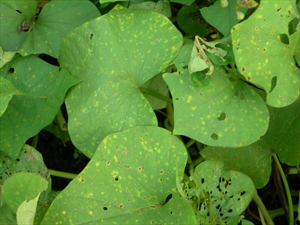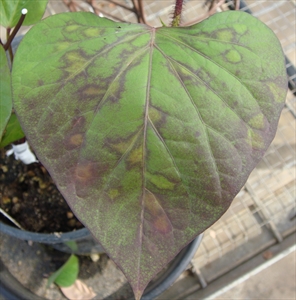Sweetpotato feathery mottle virus, internal cork disease of sweetpotato
Pacific Pests, Pathogens, Weeds & Pesticides - Online edition
Pacific Pests, Pathogens, Weeds & Pesticides
Sweetpotato feathery mottle (258)
Sweetpotato feathery mottle potyvirus; the abbreviation is SPFMV; there are different strains: ordinary (O), russet crack (RC), East African (EA), and severe (S).
Asia, Africa, North, South and Central America, the Caribbean, Europe (restricted), Oceania. It is present in Fiji, French Polynesia, Papua New Guinea, Solomon Islands, and Tonga. The strains are distributed as follows:
- EA - East Africa;
- RC - Asia, Africa, Australia, North America
- O - Africa, Asia, South America
- S - Africa, Asia, Australia, North and South America
Sweetpotato, and other (wild) Ipomoea species.
Symptoms depend on the sweetpotato variety, its age, and the conditions under which it is growing; they also depend on the severity of the SPFMV strain, and whether it is alone or present in the plant with other viruses.
On its own, there may be yellow spots (Photo 1), or purple ring spots (Photo 2). Feathery patterns may appear along the veins, and these too may be yellow or purple (Photos 3&4). In many cases, there are no symptoms, or they are faint and short-lived, with the new leaves looking healthy.
On the roots, the symptoms, depend on the strain and the variety. Strain O does not produce symptoms, whereas strain RC causes external cracking in rings around the storage roots (Photo 5), and internal cork – small brown to black corky spots, seen after harvest and during storage.
When SPFMV occurs in plants together with other viruses, e.g., Sweetpotato chlorotic stunt virus, its concentration becomes very high and severe yellowing and stunting occurs. Symptoms of this kind occur in Africa and South America.
Spread of SPFMV occurs in three ways: i) by aphids (Photo 6) in a non-persistent way; this means that the aphids pick up the virus very quickly as they feed on the sap of an infected plant, and then pass it to a healthy plant when they feed next, but the ability to infect is lost quickly; ii) the virus is spread in cuttings used for planting; and iii) the virus is spread in storage roots sent to markets: buyers often take the roots and grow sprouts from them for planting; this is a way of introducing a new variety of virus.
Survival of SPFMV between crops or cropping seasons occurs in vines left in the field after harvest, in storage roots discarded in the field or intentionally kept as a source of planting material, and also in wild Ipomoea species such as morning glory.
The impact from SPFMV infection is not well known in Pacific island countries. The virus is common, but on its own it probably does little harm to most local varieties. It is different in Australia where SPFMV is also common, but the commercial variety, Beauregard, is very susceptible to infection.
Surveys in Papua New Guinea and Solomon Islands have found several viruses, so it is possible that infections of different viruses occur which effect storage root shape, colour, time to maturity and yield. In Papua New Guinea, for instance, the following viruses have been recorded:
- Sweetpotato feathery mottle
- Sweetpotato virus G
- Sweetpotato mild mottle
- Sweetpotato chlorotic fleck
- Sweetpotato caulimo-like
- Sweetpotato ringspot
- Sweetpotato begomovirus
In Papua New Guinea, dual infections of SPFMV and Sweetpotato virus G are common, but what effect they have on the growth of plants is not known. Elsewhere, it is known that dual and multiple infections are important. For instance, in both East and West Africa the combination of SPFMV and Sweetpotato chlorotic stunt virus (SPCSV) results in sweet potato virus disease and, in Argentina, SPFMV with SPCSV and Sweetpotato mild speckling virus results in a disease known as sweetpotato chlorotic dwarf. Both are severe diseases of sweetpotato.
It is not possible to identify SPFMV on symptoms alone as often there are none. Detection depends on grafting shoots from sweet potato onto Ipomoea setosa, which is used as an 'indicator' plant as it is susceptible to all known sweetpotato viruses. If symptoms occur, the sap is then tested using antibodies to sweetpotato viruses (ELISA) or by using molecular methods (PCR) to identify the virus.
CULTURAL CONTROL
Virus-tested planting material
The most useful cultural control measures is to use virus-tested planting material. This is the method of control used for this and many other virus diseases affecting sweet potato, in Australia, China, South Africa and the USA; it is also a method under investigation in Papua New Guinea. Plants are tested for virus and, if infected, given heat treatment before removing the meristem and growing it into a healthy plant in tissue culture. The plant is then re-tested and, if free from virus, multiplied and cuttings are released to growers. (Note, these methods remove all known viruses and also sweet potato little leaf phytoplasma disease (see Fact Sheet no. 55).
Before planting:
- Use planting material, produced through a healthy 'seed' scheme.
- Remove wild Ipomoea species if they are present around the sweet potato plantings, in case they are hosts of SPVG.
After harvest:
- Remove old, harvested, vines and, if possible, plant new crops away from older ones that might be a source of aphids and viruses.
RESISTANT VARIETIES
There are resistant varieties, and some in Papua New Guinea show relatively little difference in yield of storage roots between plants that are infected by SPFMV and those free from infection.
CHEMICAL CONTROL
Not a method that can be used to control this virus. The transfer of virus from aphid to plant occurs quickly, and this means that by the time an insecticide has killed the aphid, infection has already taken place.
AUTHOR Grahame Jackson
Information from CABI (2015) Sweet potato feathery mottle virus (internal cork disease of sweet potato). Crop Protection Compendium. (https://www.cabi.org/cpc/datasheet/50963); and from Dennien et al. (2013) Growing healthy sweetpotato: best practices for producing planting material. ACIAR Monograph no. 153. Australian Centre for International Agricultural Research, Canberra. 176 pp. Photo 2 Sandra Dennien, Gatton Research Facility, DAF, Queensland. (https://www.aspg.com.au/wp-content/uploads/2015/02/Sweetpotato-virus-detection-review-2018.pdf).
Produced with support from the Australian Centre for International Agricultural Research under project PC/2010/090: Strengthening integrated crop management research in the Pacific Islands in support of sustainable intensification of high-value crop production, implemented by the University of Queensland and the Secretariat of the Pacific Community.









